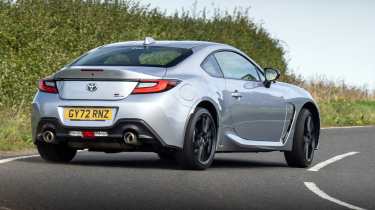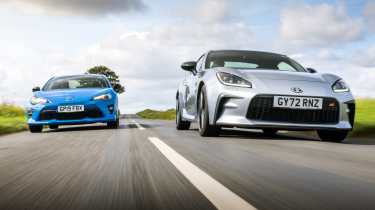Toyota GR86 Fast Fleet test – three months in the budget sports coupe
It shines in shorter tests, but what’s the GR86 like to live with day-in, day-out? We now have the answer
Never have I been more apprehensive about the arrival of a new long-termer with my name on it. I know I shouldn’t have been. I hadn’t yet driven a GR86, but I’d read all the glowing reviews, heard my colleagues rave about it, and gasped at its second-place finish at eCoty 2022. (Second place! Ahead of the Ferrari 296 GTB and McLaren Artura!) Yet still I had doubts. Maybe they all liked it but I wouldn’t…
The problem – my problem – was that I couldn’t separate the abilities of the GR86 from those of its GT86 predecessor. And the GT86 was a car I never really ‘got’. Its elevator pitch sounded like the stuff of real-world performance car dreams: affordable, compact, light, manual, rear-drive, modest power, minimal grip. However, in reality I struggled to find the enjoyment in driving pretty much everywhere with the accelerator pedal jammed into the carpet, listening to a strained-sounding engine slowly clawing its way up the rev range. And that was just when trying to keep pace with regular traffic. Then a good corner would arrive and the front and rear ends of the car would strike up an argument about which can grip the least when you were just trying to slice cleanly through the turn and be on your way. How tedious.
More reviews
> Toyota GR Yaris Gen 2 2024 review: rally-bred hot hatch is better than ever
Could the GR86 really be so much better? Well yes, of course it could. It didn’t take me much more than one short straight and two decent corners to be convinced that the GR was a very different car indeed. The naturally aspirated boxer engine’s 389cc capacity increase, taking it to 2.4 litres and giving an extra 34bhp and 33lb ft of torque (for 231bhp and 184lb ft in total), makes the world of difference. Acceleration stops being a protracted chore, overtaking no longer requires Ehra-Lessien-length straights, and the grating edge to the earlier car’s engine note in the cabin is gone too.
The extensive measures that have increased the GR86’s rigidity by a claimed 50 per cent also very quickly became apparent. Where bumpy roads could have its predecessor’s rear-view mirror shuddering like it was attached to an old-school convertible, this trait is all but eradicated in the GR, evidence of the stiffer platform that the revised suspension (still MacPherson struts front, double wishbones rear) has to work with. Couple this with ‘proper’ Michelin Pilot Sport 4 tyres, rather than that infamous Prius-spec eco rubber, and you have a car that feels much more amenable to the idea of going around corners, yet whose grip is still far from unbreakable.
Such is the transformation from GT to GR it’s almost a shame that, visually, the latter is clearly an evolution of the former, as it can taint your opinion of the newer car – if you’re a doubter like me, anyway. But the carry-over is all part of what makes the GR86 so affordable. In an age when even the dullest of cars can carry a ‘how much?!’ price tag, the GR’s figure of £32,495 never ceased to amaze me, especially as we’re talking about a bespoke model here, not a heated-up version of some mundane mass-market machine.
Our car, registered pre price rise in October 2022, was just £30,140 when new, including £645 for Ice Silver metallic paint – its only option. The GR86 already has all the mod-cons you really need, though – dual-zone air-con, heated seats, Apple CarPlay and Android Auto, cruise control, a reversing camera, dusk-sensing headlights, etc – and while the cabin isn’t what you’d call plush, after a few days of acclimatisation (particularly if you’ve just switched to the Toyota from, say, a £70k Audi TT RS) it soon becomes something that doesn’t cross your mind. After all, this car is predominantly about the driving experience it offers, not interior fripperies that might impress that friend who can barely tell one end of a car from the other.
And the GR86 is one of those performance cars that you are able to enjoy far more of the time than some. That just-so power output helps, being enough to entertain, but not so much that those outside the car think they’ve just witnessed Bloodhound SSC undergoing shakedown testing. So does the car’s slim frame (1775mm), which opens up so many narrower two-lane roads as your playground – the kind of roads where in a wider car you’d find yourself slowing down, breathing in and possibly saying a little prayer every time another car approached in the opposite direction.
Come the corners and the GR’s Torsen-diff-equipped chassis could be enjoyed whatever your level of ability or mood. With the stability control fully on you could often tease out a satisfying hint of line-tightening yaw, although mid-corner bumps could trigger an intervention and spoil the flow. Selecting Track mode would allow more freedom, but kept the electronics on standby to catch you if required. This wasn’t the most sophisticated assistance of its kind, granted, but nor did it give you a false sense of your talents. Or, of course, you could go full commando and find your own limits. These options, combined with that friendly power output, meant you never felt like you needed to down some brave pills to experience what the car had to offer. If the Toyota GR86 had a middle name, it would be ‘Accessible’.
In fact, something about this feeling that it imparted, aided by its size, weight (just 1276kg) and simplicity (manual gearbox, natural aspiration, passive dampers), frequently cast my mind back to driving quick cars from 25 or 30 years ago. The GR86 is objectively superior to them all in every respect, no doubt, but it captures their spirit, without the flaws. Where so many modern driver’s cars can feel so bloody serious, the GR86 is just out for some good ol’ carefree fun.
And when you’re not driving for fun? I had wondered if those same ingredients and characteristics might make it hard work to live with, but in fact that never came to bear. It was always comfortable, helped by its relatively relaxed ride quality, and was big enough inside not to feel claustrophobic. There was also a surprisingly good amount of luggage space, thanks to some pointless ‘plus two’ rear seats that could be folded flat to increase the load area. And at motorway speeds the flat-four would step into the background, emitting a distant bassy drumming sound while simultaneously delivering just shy of 40mpg. I wouldn’t go as far as to call the GR86 a mini grand-tourer, but I tackled a couple of five-hour journeys in it and didn’t find it unusually tiring or tiresome.
So much to like, then, but there were some black marks. Even towards the end of our three months with GY72 RNZ, I still found it required far too much of my concentration to pull away from a standstill with passenger-pleasing levels of smoothness, particularly when the engine wasn’t fully warmed up. (Conversely, my heel-and-toe technique had never been more consistent, thanks to pedal positions, weights and responses that suited me to a tee.) The reach of the dipped headlights seemed inadequate on unlit roads, so cancelling full beam for oncoming traffic usually had to be accompanied by a drop in speed to around 50mph. The windscreen on our car had a horizontal ripple that was an annoying distraction for shorter drivers (but was thankfully just below my eye-line). The handy gear indicator at the centre of the instruments would occasionally go AWOL without any obvious explanation. The creaking of the seatbelt in the leather retaining hoop on the top corner of the seat was a frequent source of irritation. And I was reminded of the folly of black wheels after RNZ’s rear-left brushed against a rock hiding in a grass verge, leaving an exposed-metal scuff that would have been barely noticeable on a silver alloy but was a glaring carbuncle when set against black. (A mobile technician from ‘Revive!’ magicked the offending mark away for £108.)
But none of these was a deal-breaker for me. I could happily have lived with our GR for much, much longer. My admiration for what this car does was still growing, which I would imagine is a feeling being experienced by the lucky few who have secured one of the limited numbers of GR86s that have come to our shores. That number is set to stay low, however, as production has now ended, the model killed by the need to relocate the ADAS sensors for incoming safety regulations, a change that would necessitate redesigning the entire roof of the car, which is something Toyota can’t justify the expense of. What a crying shame that such a true hero car is being cut down in its prime – and by features that owners of this type of car would be unlikely to use.
If you’re tempted by a GR86 the good news is that there are still a good number of delivery-mileage examples to be found in the classifieds at the £31‑32k mark. That’s an absolute bargain if you ask me. Let’s see if our deputy editor agrees. – Ian Eveleigh
Getting some miles in the Fast Fleet Toyota was my first opportunity to experience a GR86 in customer spec after driving the pre-production prototype on road and track in Spain in late 2021. I adored that car, and I was intrigued to see what it would be like to live with the finished version. I didn’t quite beg Ev for the keys but I did suggest very enthusiastically that he must try the Fast Fleet BMW M4, and how about we swap cars for a week or two?
Perhaps like an idyllic holiday or an amazing night out that’s never quite the same if you go back and try and recreate it, I didn’t fall as hard for this silver car as I did the camouflaged prototype – maybe because I’d built the memory of driving it up so much in my head. Its handling didn’t feel quite as poised, stumbling into oversteer a little abruptly (a little like the old GT86 used to on its lower-grip tyres, albeit to a lesser extent), to the point that I double-checked the tyre pressures to make sure nothing was awry.
Accessible oversteer and a slightly silly dynamic temperament is all part of the car’s fun and appeal, of course, it just had a bit less finesse than I recalled. The ride quality, too, was a little more fractious than I’d expected. But it is a sports car, after all.
I’m fine with the slightly low-rent interior, too, and its Fisher Price-esque controls; it’s a step forward over the old GT86 interior (which I didn’t mind either) although some of the trim plastics were sporting scratches already. I really liked the digital instrument panel’s clear display in Track mode, although that adds a lap-timer function I kept accidentally activating and failing to cancel.
There’s a fair bit of road noise, but if you buy a car like this for long-distance refinement then you’re doing it wrong. And the enlarged engine’s extra torque makes it a less draining car in general to drive over distance than the GT86.
Like the GT86, the gearchange errs on the knuckly side, and it needs concentration, especially as the bite point is right at the top of the clutch pedal in this particular car, but it’s lovely to have a gearchange that you have to concentrate on.
And lovely to drive the GR86 in general. I think perhaps the reason I found myself being more nitpicky than usual is because I was just trying to make myself feel better about not being able to buy one. I tried (and failed) doing some man-maths to work out if I could make an offer to Toyota to keep this one. As far as I know it’ll go into the Toyota dealer network after our loan. Whoever goes on to own it will have a fantastic car. Sorry about that lap-timer that’s still running. – James Taylor
| Date acquired | August 2023 |
| Duration of test | 3 months |
| Total test mileage | 3196 |
| Overall mpg | 33.4 |
| Costs | £108 (wheel repair) |
| Purchase price | £30,140 |
| Value today | c£30,000 |
This story was first featured in evo issue 318.








